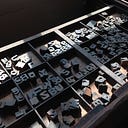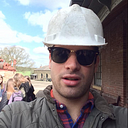“Visionary Photographer” — Clarence John Laughlin Curated by Keith F. Davis
“This book seeks to reassess the artistic achievement of Clarence John Laughlin,” reads the first sentence of a compilation of three essays about the legacy of Laughlin and his photographic career. Davis and his fellow essayists seek to reassess Laughlin through a collection of his photography instead of single images causing the objective and subjective aspects of individual images to be compared to that of others to view a larger picture of interest and influence.
Davis concludes that Laughlin’s goal was to “bridge the gap between visible reality and a metaphysical realm of fantasy and intuition,” which is essentially a characteristic of the surreal. By taking objects and putting meaning onto them that would otherwise not be known unless enhanced by the history of area or region is a form of bridging this gap in terms of the surreal. Hence we see Laughlin using the plantation home to represent a decaying Louisiana and furthermore the passing of a Southern legacy. In focusing on the symbolic use of photography instead of the literal use of a camera, Laughlin’s work is analysed within the modern conventions of photography that he helped create, yet did not receive much recognition for during his lifetime. Through the study of these essays a viewer comes to understand how Laughlin was able to practically capture the imagined, mysterious, and continuous unknown in all of his works.
To understand Laughlin, as a person, as well as his photography, the essayists go about their writing with a basic understanding that Laughlin lived his life in New Orleans during a time of turmoil and change. As a native of the South in the early twentieth century, slavery had ended, however, the Black race did not have a voice within society and as a result of the aftermath of the depression, many White people as well were struggling about the state. For them his work is a primary document of what the world looked like for one person among this backdrop. Beginning with his first images as a photographer, it is striking to Davis that Laughlin largely focused on shadows and metalwork's, mainly in the industrial parts of New Orleans. It was a decade later in the 1940's that Laughlin began experimenting with the depiction of specific objects in his work.
Davis further talks about the era of photography that Laughlin was apart of and describes how the time period was focused on defamiliarization through the utilization of images. Photographers began using extreme close-ups, tilted horizons, and other unfamiliar perspectives to render the viewer off guard in his immediate contact with an image. Laughlin, who saw this work in his American contemporary’s, also saw the French Surrealist movement in fine art and merged the two together to create a truly unique aspect of photography. While the surrealists in France were also rendering objects significance based on defamiliarization, they were focused on disorienting images of the known and blurring them with mystery, dream, and the unconscious. Laughlin, who identified as a lost and alienated Southerner sought through photographic surrealism to represent the best he could how he felt as a person by depicting objects from his region in such a light.

